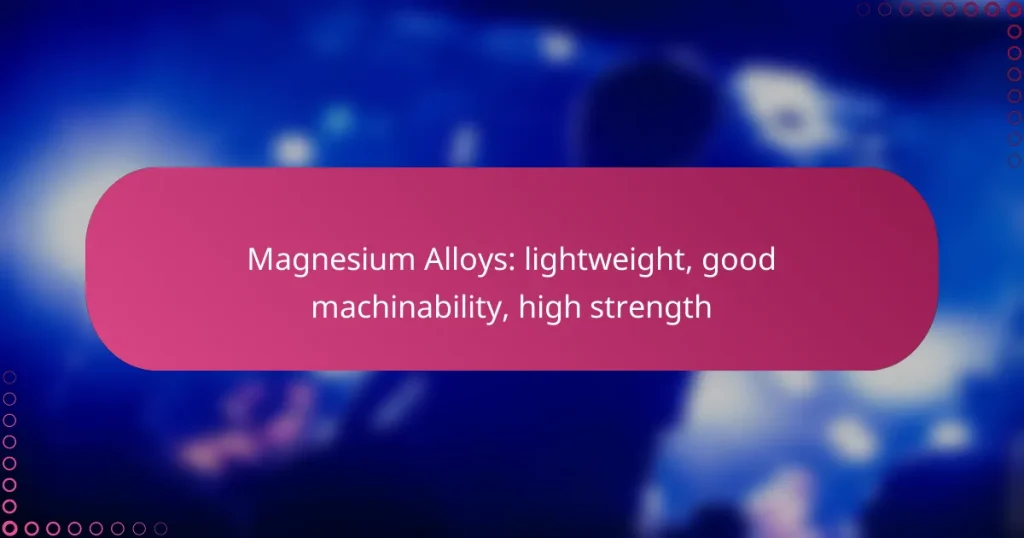Magnesium alloys are renowned for their lightweight composition, exceptional machinability, and impressive strength, making them a preferred choice in industries such as automotive and aerospace. Their unique properties not only contribute to reducing overall weight but also enhance fuel efficiency and performance in various applications.

What are the benefits of magnesium alloys?
Magnesium alloys offer several advantages, including their lightweight nature, excellent machinability, and high strength. These properties make them ideal for various applications, particularly in the automotive and aerospace industries.
Lightweight properties
Magnesium alloys are among the lightest structural materials available, often weighing about one-quarter of steel. This significant reduction in weight can lead to improved fuel efficiency and reduced emissions in vehicles and aircraft.
For applications where weight is critical, such as in aerospace components, magnesium alloys can provide substantial advantages over heavier materials. This lightweight property allows for more efficient designs and better overall performance.
Good machinability
Magnesium alloys are known for their excellent machinability, which means they can be easily shaped and formed using standard machining processes. This characteristic allows for precise manufacturing and reduces production times.
When machining magnesium, it is crucial to use the right tools and techniques to avoid issues like chip buildup. Proper coolant use and tool selection can enhance the machining process, making it more efficient.
High strength-to-weight ratio
Magnesium alloys possess a high strength-to-weight ratio, making them strong yet lightweight. This property is particularly beneficial in applications where structural integrity is essential without adding excessive weight.
For example, in automotive applications, using magnesium alloys can lead to lighter vehicles that maintain safety and performance standards. This balance of strength and lightness is a key reason for their popularity in high-performance sectors.
Corrosion resistance
While magnesium alloys can be susceptible to corrosion, they can be treated to enhance their resistance. Surface treatments like anodizing or applying protective coatings can significantly improve their durability in harsh environments.
In applications exposed to moisture or corrosive substances, it is essential to consider these protective measures to extend the lifespan of magnesium components. Proper maintenance and care can also mitigate corrosion risks.
Thermal conductivity
Magnesium alloys exhibit good thermal conductivity, which allows for efficient heat dissipation. This property is advantageous in applications where temperature control is critical, such as in engine components or electronic housings.
When designing systems that require effective heat management, incorporating magnesium alloys can help maintain optimal operating temperatures, thereby enhancing overall performance and reliability.

How are magnesium alloys used in aerospace?
Magnesium alloys are widely used in aerospace due to their lightweight nature, excellent machinability, and high strength. These properties make them ideal for reducing overall aircraft weight and improving fuel efficiency while maintaining structural integrity.
Aircraft components
In aircraft manufacturing, magnesium alloys are commonly utilized for components such as engine casings, brackets, and gearboxes. Their low density helps decrease the overall weight of the aircraft, which can lead to significant fuel savings over time.
Manufacturers often choose magnesium alloys for parts that require intricate shapes and precise tolerances, as these materials can be easily machined. However, it’s essential to consider corrosion resistance and protective coatings when using magnesium in exposed areas.
Spacecraft structures
Magnesium alloys play a crucial role in spacecraft structures, particularly in components like satellite frames and housing for sensitive instruments. Their lightweight properties help minimize launch costs by reducing the overall mass of the spacecraft.
When designing spacecraft, engineers must account for the thermal properties of magnesium alloys, as they can be sensitive to extreme temperatures. Proper thermal management and protective measures are necessary to ensure the longevity and reliability of these structures in space.
Helicopter parts
In helicopters, magnesium alloys are often used for components such as rotor hubs and transmission casings. The strength-to-weight ratio of these alloys allows for enhanced performance and agility during flight.
It is important to ensure that magnesium parts in helicopters are adequately treated to prevent corrosion, especially in environments with high humidity or exposure to saltwater. Regular inspections and maintenance can help extend the lifespan of these components.

What are the key applications of magnesium alloys in automotive?
Magnesium alloys are increasingly used in the automotive industry due to their lightweight properties, good machinability, and high strength. These characteristics make them ideal for enhancing fuel efficiency and performance in various vehicle components.
Engine components
Magnesium alloys are commonly used in engine components such as cylinder heads and engine blocks. Their lightweight nature helps reduce overall vehicle weight, which can improve fuel efficiency and performance. Additionally, magnesium’s excellent thermal conductivity aids in effective heat dissipation, crucial for engine operation.
Transmission housings
Transmission housings made from magnesium alloys offer significant weight savings compared to traditional materials like aluminum or steel. This reduction in weight contributes to better vehicle dynamics and efficiency. Moreover, magnesium’s good machinability allows for complex shapes and designs, enhancing the overall performance of the transmission system.
Wheels and chassis
Magnesium alloys are utilized in wheels and chassis components to achieve a balance of strength and weight. Using magnesium for wheels can lead to lower unsprung weight, which improves handling and ride comfort. For chassis applications, magnesium’s high strength-to-weight ratio allows for robust designs that maintain structural integrity while minimizing weight.

What factors should be considered when selecting magnesium alloys?
When selecting magnesium alloys, key factors include mechanical properties, cost-effectiveness, and the manufacturing processes involved. Each of these elements plays a crucial role in determining the suitability of a specific alloy for a given application.
Mechanical properties
Magnesium alloys are known for their lightweight nature and high strength-to-weight ratio, making them ideal for applications in aerospace and automotive industries. Key mechanical properties to consider include tensile strength, yield strength, and fatigue resistance, which can vary significantly among different alloys.
For instance, wrought magnesium alloys typically exhibit better mechanical properties compared to cast alloys. It’s essential to assess the specific requirements of your application to choose an alloy that meets the necessary strength and durability standards.
Cost-effectiveness
Cost-effectiveness is a critical consideration when selecting magnesium alloys, as prices can vary based on the alloy composition and processing methods. Generally, magnesium alloys are more expensive than aluminum but offer superior performance in certain applications.
When evaluating cost, consider not only the material price but also the potential savings in weight and fuel efficiency, especially in transportation sectors. A thorough cost-benefit analysis can help determine if the investment in magnesium alloys is justified for your project.
Manufacturing processes
The manufacturing processes for magnesium alloys include casting, extrusion, and machining, each with its advantages and limitations. Casting allows for complex shapes but may result in lower mechanical properties, while extrusion offers better strength but may limit design flexibility.
Machining is often required to achieve precise dimensions, and it is important to select appropriate tooling and techniques to avoid issues like chip formation and tool wear. Understanding the specific manufacturing needs can guide the selection of the most suitable magnesium alloy for your application.

What are the challenges of using magnesium alloys?
Magnesium alloys present several challenges, including flammability, corrosion susceptibility, and limited availability of certain grades. These factors can impact their application in various industries, necessitating careful consideration during design and manufacturing processes.
Flammability concerns
One of the primary challenges with magnesium alloys is their flammability. When exposed to high temperatures or open flames, magnesium can ignite and burn at a high intensity, making it a safety concern in manufacturing and handling environments.
To mitigate flammability risks, it is crucial to implement proper safety protocols, such as using fire-resistant materials in conjunction with magnesium components and maintaining strict temperature controls during processing. Additionally, training personnel on handling procedures can significantly reduce the likelihood of ignition.
In industries where magnesium alloys are used, such as aerospace and automotive, adherence to safety standards and regulations is essential. Familiarity with guidelines from organizations like the National Fire Protection Association (NFPA) can help ensure compliance and enhance safety measures.


